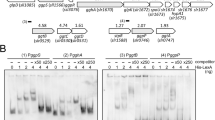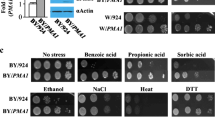Abstract
How cells of the fission yeast Schizosaccharomyces pombe respond to alkaline stress is not well understood. Here, to elucidate the molecular mechanism underlying the alkaline stress response in S. pombe, we performed DNA microarray analysis. We found that a homolog of human catechol O-methyltransferase 2 (COMT2) is highly upregulated in S. pombe cells exposed to alkaline conditions. We designated the S. pombe homolog as cmt2+ and also identified its paralog, cmt1+, in the S. pombe genome. Reverse transcription PCR confirmed that both cmt1+ and cmt2+ are upregulated within 1 h of exposure to alkaline stress and downregulated within 30 min of returning to an acidic environment. Moreover, we verified that recombinant Cmt proteins exhibit catechol O-methyltransferase activity. To further characterize the expression of cmt1+ and cmt2+, we carried out an EGFP reporter assay using their promoter sequences, which showed that both genes respond not only to alkaline but also to salt stress. Collectively, our findings indicate that the cmt promoter might be an advantageous expression system for use in S. pombe under alkaline culture conditions.





Similar content being viewed by others
References
Alfa C, Fantes P, Hyams J, McLoed M, Warbrick E (1993) General introduction to S. pombe. Experiments with fission yeast: a laboratory course manual. Cold Spring Harbor Laboratory Press Cold Spring Harbor, NY, pp 1–11
Bulmer R, Pic-Taylor A, Whitehall SK, Martin KA, Millar JB, Quinn J, Morgan BA (2004) The forkhead transcription factor Fkh2 regulates the cell division cycle of Schizosaccharomyces pombe. Eukaryot Cell 3:944–954
Caddick MX, Brownlee AG, Arst HN Jr (1986) Regulation of gene expression by pH of the growth medium in Aspergillus nidulans. Mol Gen Genet 203:346–353
Canadell D, García-Martínez J, Alepuz P, Pérez-Ortín JE, Ariño J (2015) Impact of high pH stress on yeast gene expression: a comprehensive analysis of mRNA turnover during stress responses. Biochim Biophys Acta 1849:653–664
Chaleckis R, Ebe M, Pluskal T, Murakami I, Kondoh H, Yanagida M (2014) Unexpected similarities between the Schizosaccharomyces and human blood metabolomes, and novel human metabolites. Mol BioSyst 10:2538–2551
Higuchi Y, Mori H, Kubota T, Takegawa K (2018) Analysis of ambient pH stress response mediated by iron and copper intake in Schizosaccharomyces pombe. J Biosci Bioeng 125:92–96
Iacovoni JS, Russell P, Gaits F (1999) A new inducible protein expression system in fission yeast based on the glucose-repressed inv1 promoter. Gene 232:53–58
Kainou T, Shinzato T, Sasaki K, Mitsui Y, Giga-Hama Y, Kumagai H, Uemura H (2006) Spsgt1, a new essential gene of Schizosaccharomyces pombe, is involved in carbohydrate metabolism. Yeast 23:35–53
Lamb TM, Mitchell AP (2003) The transcription factor Rim101p governs ion tolerance and cell differentiation by direct repression of the regulatory genes NRG1 and SMP1 in Saccharomyces cerevisiae. Mol Cell Biol 23:677–686
Lamb TM, Xu W, Diamond A, Mitchell AP (2001) Alkaline response genes of Saccharomyces cerevisiae and their relationship to the RIM101 pathway. J Biol Chem 276:1850–1856
Männistö PT, Kaakkola S (1999) Catechol-O-methyltransferase (COMT): biochemistry, molecular biology, pharmacology, and clinical efficacy of the new selective COMT inhibitors. Pharmacol Rev 51:593–628
Matsuzawa T, Hara F, Tohda H, Uemura H, Takegawa K (2012) Promotion of glycerol utilization using ethanol and 1-propanol in Schizosaccharomyces pombe. Appl Microbiol Biotechnol 95:441–449
Matsuzawa T, Tohda H, Takegawa K (2013) Ethanol-inducible gene expression using gld1 + promoter in the fission yeast Schizosaccharomyces pombe. Appl Microbiol Biotechnol 97:6835–6843
Maundrell K (1993) Thiamine-repressible expression vectors pREP and pRIP for fission yeast. Gene 123:127–130
Peñalva MA, Lucena-Agell D, Arst HN Jr (2014) Liaison alcaline: Pals entice non-endosomal ESCRTs to the plasma membrane for pH signaling. Curr Opin Microbiol 22:49–59
Pic A, Lim FL, Ross SJ, Veal EA, Johnson AL, Sultan MR, West AG, Johnston LH, Sharrocks AD, Morgan BA (2000) The forkhead protein Fkh2 is a component of the yeast cell cycle transcription factor SFF. EMBO J 19:3750–3761
Pluskal T, Nakamura T, Villar-Briones A, Yanagida M (2010) Metabolic profiling of the fission yeast S. pombe: quantification of compounds under different temperatures and genetic perturbation. Mol BioSyst 6:182–198
Serra-Cardona A, Canadell D, Ariño J (2015) Coordinate responses to alkaline pH stress in budding yeast. Microb Cell 2:182–196
Serrano R, Ruiz A, Bernal D, Chambers JR, Ariño J (2002) The transcriptional response to alkaline pH in Saccharomyces cerevisiae: evidence for calcium-mediated signalling. Mol Microbiol 46:1319–1333
Serrano R, Bernal D, Simón E, Ariño J (2004) Copper and iron are the limiting factors for growth of the yeast Saccharomyces cerevisiae in an alkaline environment. J Biol Chem 279:19698–19704
Tilburn J, Sarkar S, Widdick DA, Espeso EA, Orejas M, Mungroo J, Peñalva MA, Arst HN Jr (1995) The Aspergillus PacC zinc finger transcription factor mediates regulation of both acid- and alkaline-expressed genes by ambient pH. EMBO J 14:779–790
Vivancos AP, Jara M, Zuin A, Sansó M, Hidalgo E (2006) Oxidative stress in Schizosaccharomyces pombe: different H2O2 levels, different response pathways. Mol Gen Genomics 276:495–502
Yoritsune K, Higuchi Y, Matsuzawa T, Takegawa K (2014) Functional analysis of putative phosphoenolpyruvate transporters localized to the Golgi apparatus in Schizosaccharomyces pombe. FEMS Yeast Res 14:1101–1109
Acknowledgements
We would like to thank Tetsuya Kotani, Takeo Kubota, and Rinko Nakayama for the technical help.
Funding
This study was funded by JSPS KAKENHI grant number JP17H03966 (KT).
Author information
Authors and Affiliations
Corresponding author
Ethics declarations
Conflict of interest
The authors declare that they have no conflict of interest.
Ethical approval
This article does not contain any studies with human participants or animals performed by any of the authors.
Additional information
Publisher’s note
Springer Nature remains neutral with regard to jurisdictional claims in published maps and institutional affiliations.
Electronic supplementary material
ESM 1
(PDF 345 kb)
Rights and permissions
About this article
Cite this article
Tominaga, A., Higuchi, Y., Mori, H. et al. Catechol O-methyltransferase homologs in Schizosaccharomyces pombe are response factors to alkaline and salt stress. Appl Microbiol Biotechnol 103, 4881–4887 (2019). https://doi.org/10.1007/s00253-019-09858-0
Received:
Revised:
Accepted:
Published:
Issue Date:
DOI: https://doi.org/10.1007/s00253-019-09858-0




